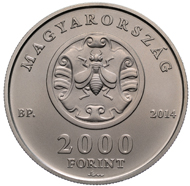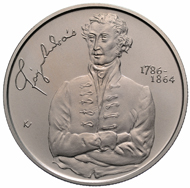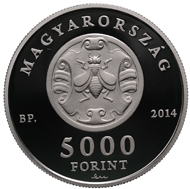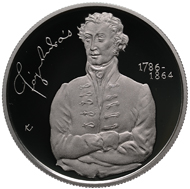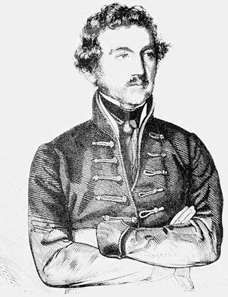August 7, 2014 – By issuing a collector coin marking the 150th anniversary of his death, the Magyar Nemzeti Bank honours the life and work of András Fáy, founder of the First Hungarian Savings Bank.
Hungary/ 2,000 HUF/ Cu75Ni25/ 12.5 g/ 30 mm/ Mintage: 5,000.
The front of the coin depicts an ornamental element of the ground floor façade of the headquarters of the Savings Bank designed by Miklós Ybl (now located in Károlyi utca, Budapest), a bee collecting pollen, as rendered by the sculptress Márta Csikai. The back of the coin was designed by Vilmos Király and shows a half-figure of Fáy. The coin will be presented during the ceremony unveiling the stele marking the Reformed Church at Kálvin tér as a historical landmark, which was erected by the Institute of National Heritage on the anniversary of Fáy’s death.
Hungary/ 5,000 HUF/ Silver .925/ 12.5 g/ 30 mm/ Designers: obv. Márta Csikai, rev. Vilmos Király/ Mintage: 5,000.
“He was everything for his country, one of the nation’s most industrious and useful sons, who selflessly dedicated his whole life to his country, not expecting anything in return and giving freely of his own. He was a calm, serious man, who applied his intellect and knowledge in a thousand ways, working tirelessly and unerringly, in good spirits and with great foresight. He recalled all of his work and deeds with happiness and thus honestly deserved the title of a happy wise man,” wrote his cousin, Pál Szemere, and based on this description the writer Kálmán Mikszáth christened Fáy “the nation’s man for all occasions”.
András Fáy: Poet, novelist, short story writer and playwright.
András Fáy was born to a Calvinist family in Zemplén county. He studied in Sárospatak and Pozsony (today Bratislava, Slovakia) and was later admitted to the bar, although he never practiced law. From the 1820s until the mid-1840s, he was an outstanding figure in Hungarian public life alongside Széchenyi and was one of the key intellectual and political leaders in the transformation of Hungary’s civil society. Until the rise of Kossuth, he was the head of the opposition in Pest, and from 1835 he was the diet’s representative from Pest county. His name is associated with the first Hungarian social novel, “The House of the Béltekys”.
When necessary, he also worked as a theatre director and organiser, and was a patron of the Hungarian theatre scene. Nevertheless, his name is probably most closely linked to the foundation of the First Hungarian Savings Bank of Pest, and he also laid the groundwork for the foundation of the first Hungarian insurance company. He retired from public life to his estate in Gomba in 1849. Although statesman Ferenc Deák was counting on his assistance in crafting the Compromise of 1867, Fáy’s health no longer allowed it. He is buried together with his son in a crypt at the Reformed Church at Kálvin tér, now a historical landmark, and their tomb has been registered as a national memorial gravesite.
“To work for the good! That was my life’s goal and motto,” Fáy once said, describing his own work. “Inscribe on my tomb, ‘He always wished well and worked for the common good.’”
Click here to visit the Hungarian Mint online.





